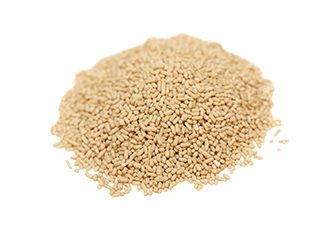
Active dried wine yeast.
It can be accepted that Noah did not know that yeast, which is not visible to the naked eye, was responsible for his shameful behaviour after he had tasted his drink. The development of pure culture yeast to control the results of the alcoholic fermentation of grape juice took place over several years and different forms of pure culture yeast have also developed. Initially it was used in liquid form and it was only since the 1950s that it became available as activated dried yeast. In all cases pure culture yeast was associated with Saccharomyces cerevisiae. This association is possibly changing.
Saccharomyces cerevisiae as the base of wine yeast has possibly come to an end regarding its diversification to offer new characteristics. If this is seen as the reality it can be speculated about the possibilities to remain innovative. One possibility remains the breeding of yeasts with yeast strains of Saccharomyces cerevisiae which have characteristics that are not presently occurring in commercial yeast strains. Otherwise hybrids of Saccharomyces cerevisiae strains with related Saccharomyces species like Saccharomyces uvarum, Saccharomyces paradoxis and Saccharomyces pastorianus can be developed. It can even possibly happen that Saccharomyces cerevisiae strains can be hybridised with yeast genera of the same family (Saccaromycetaceae) like Pichia, Kluyveromyces or Zygosaccharomyces. Genes originating outside the Saccharomyces cerevisiae genome can also be utilised selectively without being limited to traditional hybridisation.
None of the above-mentioned possibilities will however probably produce results within the next years and due to the resistance against GMOs, the last mentioned is the least likely. Commercial yeast strains of Saccharomyces cerevisiae, Sachharomyces uvarum and Saccharomyces bayanus however remain popular, because they can ferment 23+ °Brix grape juice with a pH of 3.0. It is a very unique nutrient environment, wherein wild yeasts and even wild yeast strains of Saccharomyces cerevisiae cannot compete with commercial yeast strains. The only feasible practical solution to be innovative regarding pure culture yeasts is consequently the combined use of non-Saccharomyces yeast strains and commercial Saccharomyces yeast strains. In principle the non-Saccharomyces yeast strains will proliferate during the initial alcoholic fermentation until an alcohol concentration of 3 to 8 %, before it will be killed by the formed alcohol, whereafter the commercial Saccharomyces yeast strains will proliferate and complete the fermentation. Various non-Saccharomyces products are presently available. It can be isolates of species like Torulaspora delbrueckii, Metschnikowia pulcherrimia or Pichia kluveri in which case winemakers can decide which Saccharomyces strains can be used together to complete the fermentation or it can be products that are already a mixture of Saccharomyces and non-Saccharomyces strains (Philips, 2016).
Non-Saccharomyces yeasts have played a role in winemaking for more than 7 000 years. Different genera, amongst others Torulaspora, Kloeckera, Lachansea, Pichia, Candida, Metschnikovia, Schizosaccharomyces, Debaryomyces and Brettanomyces are applicable. During a spontaneous fermentation the non-Saccharomyces usually multiply in the beginning, whereafter the Saccharomyces yeasts proliferate to dominate and complete the fermentation. During a spontaneous fermentation the non-Saccharomyces yeasts play an important role during fermentation and in the final wine. Since the use of dried yeast of Saccharomyces cerevisiae strains commenced, the role of non-Saccharomyces decreased, because the initial inoculation is sufficient to dominate the yeast population. As a result of the development of dried and frozen yeast cultures it has become possible to inoculate grape juice initially with non-Saccharomyces yeasts and follow it later during the formation with a Saccharomyces-culture inoculation. All non-Saccharomyces yeasts however do not have a positive influence on wine quality. Brettanomyces bruxellensis can for example as result of the formation of vinyl- and ethylphenol cause unpleasant farmyard and medicinal flavours in wine, which has a negative influence on general wine quality. Hanseniaspora uvarum forms abnormal concentrations ethyl acetate, which can impart a volatile acid or nail polish remover character to wine.
Further research did however lead to the development of commercial non-Saccharomyces yeast products. Torulaspora delbruckeii for example forms more mannoproteins than Saccharomyces cerevisiae which will contribute to a better mouthfeel and more complex ester profile of wine. Pichia kluyveri promotes the volatile thiol concentration in Sauvignon blanc. Lachansea thermotolerans forms lactic acid, without increasing the volatile acid concentration, but can consequently increase the acid concentration of low acid wines and as result of its limited ethanol formation ability it can also be used for low alcohol wines. This yeast species occurs regularly in spontaneous fermentations in different countries. Although its lower alcohol formation is significant, the question arises which actions can be implemented to obtain alcohol reductions between 2 to 3%. One way is to use a high inoculation dosage of it, without the follow-up inoculation with Saccharomyces. Another approach can be to apply more oxidative actions during fermentation like aeration or rackings. Such conditions favour L. thermotolerans versus Saccharomyces yeasts. Further selection of L. thermotolerans regarding high lactic acid and low alcohol formation can also lead to new available strains. L. thermotolerans can also play a significant role in the actions that wine industries initiate to address global warming. As a result of the higher temperatures, grapes reach optimal ripeness at higher sugar concentrations, but lower acid concentrations and consequential higher pH’s. This can lead to wines with high alcohol concentrations and a one-dimensional palate. Instead of the adjustment of acid levels with tartaric acid additions, the use of L. thermotolerans can address low acid and high alcohol concentrations.
The use of non-Saccharomyces yeasts is a relatively new technique in the wine industry. As a result of their metabolic and other properties, which Saccharomyces species do not have, they can play an important role in the future (Swiegers et al., 2016).
References
Philips, C., 2016. Yeast of a different breed. Wine Business Monthly, August 2016: 18 – 19.
Swiegers, H., Edwards, N., Saerens, S.G. & Bjerre, K, 2016. Wine Business Monthly, August 2016: 20 – 25.













